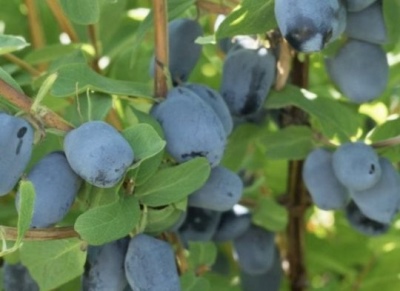
- Authors: University of Saskatchewan, Canada
- Name synonyms: Boreal Beast, Borealis, Northern Beast
- Growth type: medium-sized
- Description of the bush: upright
- Bush height, m: 1,5
- Escapes: thick, durable
- Crown: rounded
- Fruit size: large
- Fruit weight, g: 3,5
- Fruit shape: broadly oval, slightly flattened on the sides
The taste of different cultures is not all that any gardener needs to know. To get a good effect from Boreal Best honeysuckle, you will need to understand both the peculiarities of cultivation and care, and what productivity can be expected. It is certainly worth analyzing the subtleties of planting such a plant.
Breeding history
This culture was created in Canada. The fruit of the work of breeders of the University of Saskatchewan does not appear in the Russian State Plant Registry. He has several official synonyms at once:
Boreal Beast;
Borealis;
Northern monster.
Description of the variety
The type of honeysuckle, universal in its purpose, forms bushes up to 1.5 m high. Direct growth is characteristic of these bushes. Their crown is somewhat rounded. The shoots are very thick. Therefore, they are very durable and reliable.
Fruit characteristics
Large berries Boreal Best have a mass of 3.5 grams. They look like a wide oval in shape. Such fruits are slightly squeezed on all sides. They are characterized by black and purple colors. The thick rind is solid.
Its surface is covered with a waxy coating. The main part of the pulp is colored in a light purple tone. It is worth noting that the crop will not crumble. This is achieved through good attachment to the branches.
Taste qualities
Note the sweet-sour taste in the official description. It is mixed with a fruity aftertaste. And also the official description insists on the uniqueness of the scent. A tasting examination gave this plant an estimate of 4.5 points.
Ripening and fruiting
Boreal Best will bloom in May. This is a typical late-ripening plant. Berry picking starts at the end of June. It ends during September. The exact times will depend on the actual weather.
Yield
The declared ability to give an average of 5 kg per 1 bush. Therefore, it is believed that this plant has an average level of productivity. True, unlike the more fertile types, it shows a stable result.

Self-fertility and the need for pollinators
It is impossible to do without the help of other plants. For pollination of this culture, it is necessary to apply:
Northern beauty;
Northern blizzard;
Aurora;
Tundra;
Honey Bee;
Heart of the Giant.
Growing and care
The resistance to ailments is quite high. Such a plant is especially good at resisting mildew attacks. The specific moments of disembarkation are chosen at their discretion, taking into account the weather conditions. In the south, Boreal Best honeysuckle is planted both in spring and summer. However, in the middle lane, especially in the north, you will have to choose the earliest possible date.
When planting, the rhizome should be evenly distributed over the entire volume of the hole. Even a small amount of air cavities should not be left between the roots. Then the soil is compacted, and the planted plant is watered. Under normal conditions, Boreal Best is required to be irrigated 1 time per decade. But during dry periods, watering can be done every 72 hours.
Of the top dressing, the classic organic has the best reputation:
bird droppings;
cow dung;
compost.
Mineral dressings are rarely used. The reason is that because of them, the bush may become thickened.With normal basic feeding of the planting hole, fertilizers begin to be applied at least 3 seasons after development. Soon after each watering or rain, the area should be loosened carefully, while avoiding trauma to the roots. Weeding is appropriate to combine with mulching.



Winter hardiness and the need for shelter
Boreal Best honeysuckle can survive frosts down to –28 degrees. In more severe cold weather, the variety necessarily requires shelter. With an industrial version of cultivation, with proper care, the plant will come in handy even in the northern regions of Russia.
Location and soil requirements
It is advisable to plant such a plant in sunny places. It is also necessary to select locations protected from cold winds. Sunlight should hit the crown, but a faint shadow should be left below it. If possible, sandy or loamy areas should be preferred. It is even better if the soil is water and air permeable.
In low-lying areas, embankments with a height of 30 cm are formed.In addition, a drainage layer will be required, which is created from:
expanded clay;
brick fight;
rubble.
































































